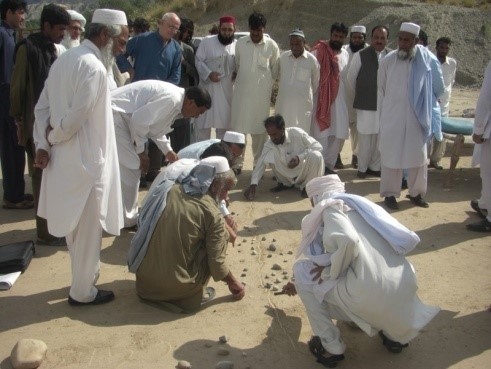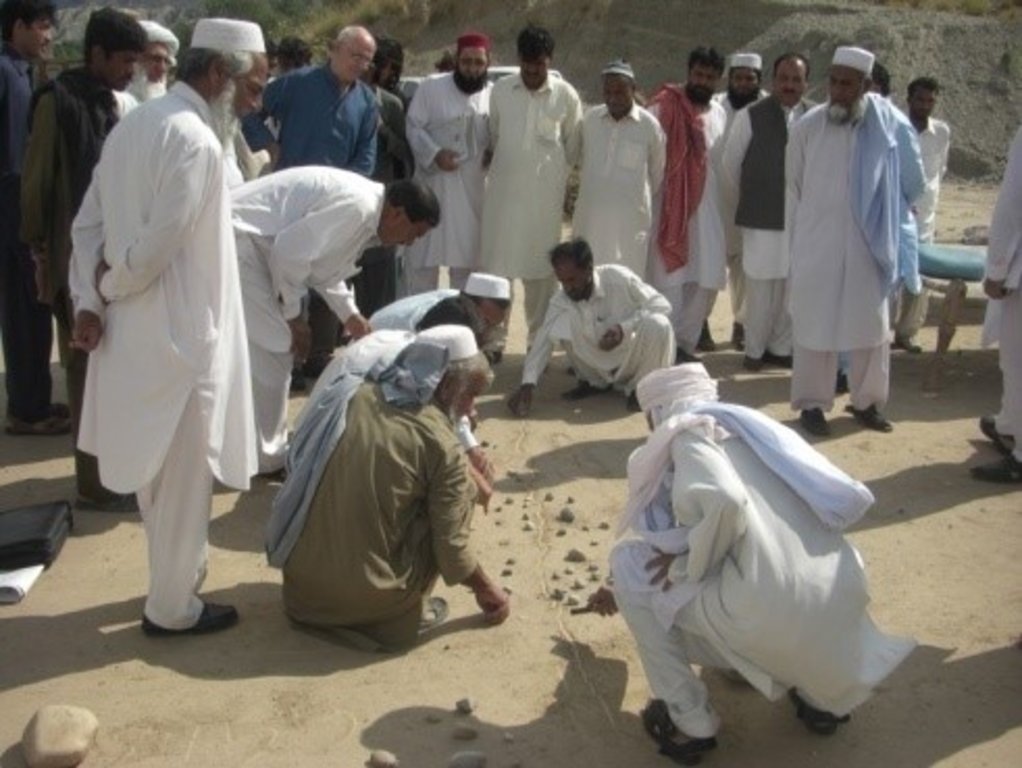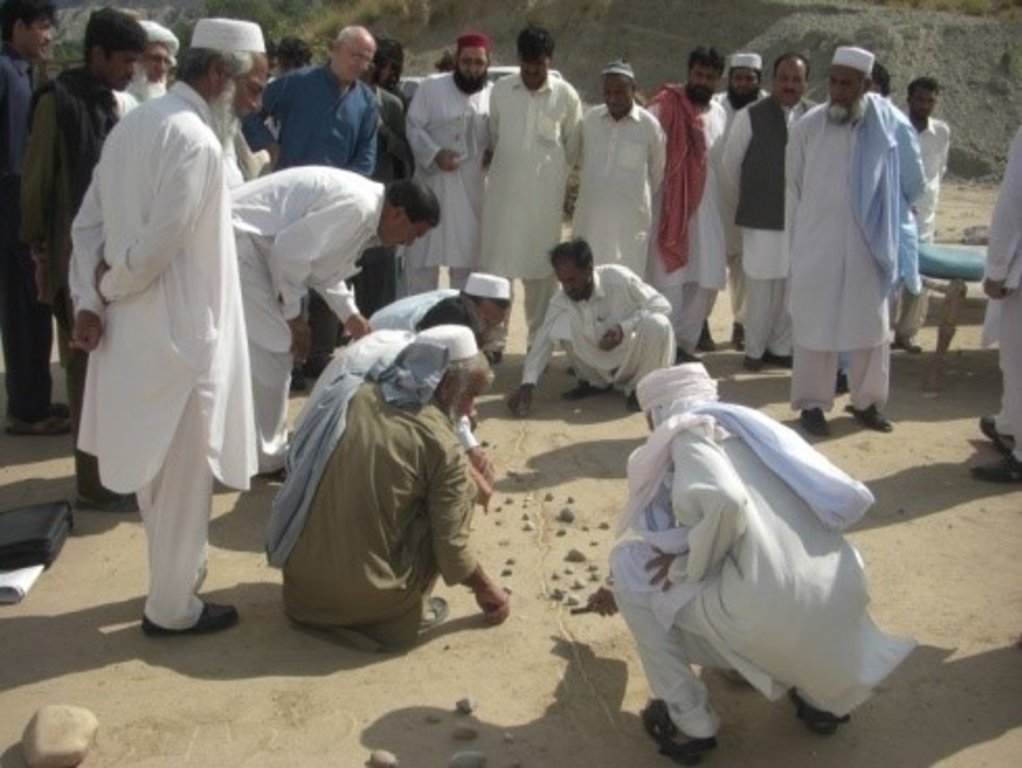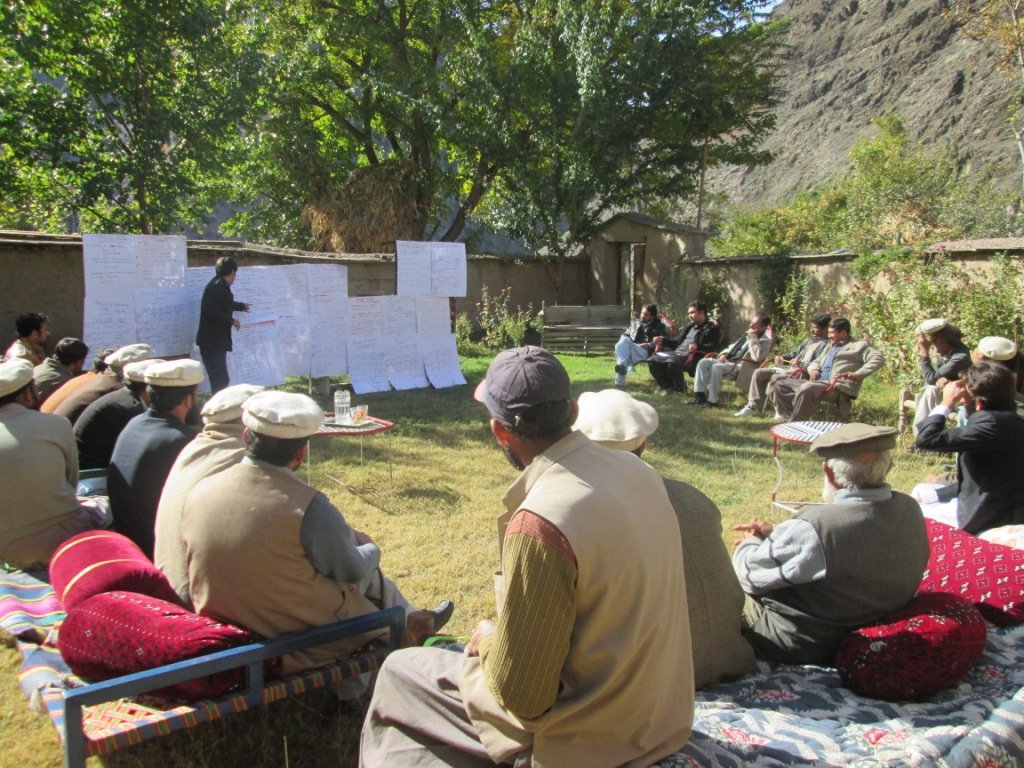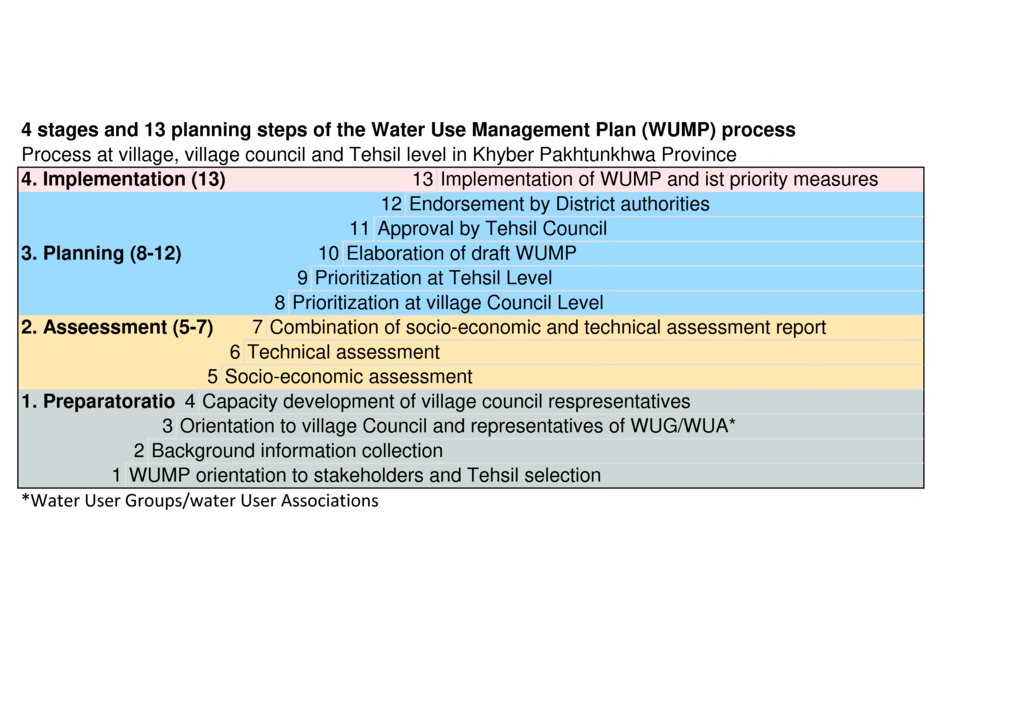Water Use Management Plan (WUMP) [ปากีสถาน]
- ผู้สร้างสรรค์:
- การอัพเดท:
- ผู้รวบรวม: Eveline Studer
- ผู้เรียบเรียง: Munawar Khan
- ผู้ตรวจสอบ: Alexandra Gavilano, Nicole Harari, Hanspeter Liniger
WUMP
approaches_747 - ปากีสถาน
ดูส่วนย่อย
ขยายทั้งหมด ย่อทั้งหมด1. ข้อมูลทั่วไป
1.2 รายละเอียดที่ติดต่อได้ของผู้รวบรวมและองค์กรที่เกี่ยวข้องในการประเมินและการจัดเตรียมทำเอกสารของแนวทาง
ชื่อของโครงการซึ่งอำนวยความสะดวกในการทำเอกสารหรือการประเมินแนวทาง (ถ้าเกี่ยวข้อง)
Book project: where people and their land are safer - A Compendium of Good Practices in Disaster Risk Reduction (DRR) (where people and their land are safer)ชื่อของโครงการซึ่งอำนวยความสะดวกในการทำเอกสารหรือการประเมินแนวทาง (ถ้าเกี่ยวข้อง)
HELVETAS (Swiss Intercooperation)1.3 เงื่อนไขที่เกี่ยวข้องกับการใช้ข้อมูลที่ได้บันทึกไว้ผ่านทาง WOCAT
วันที่เก็บรวบรวมข้อมูล (ภาคสนาม):
15/11/2014
ผู้รวบรวมและวิทยากรหลักยอมรับเงื่อนไขเกี่ยวกับการใช้ข้อมูลที่ถูกบันทึกผ่านทาง WOCAT:
ใช่
1.4 การอ้างอิงถึงแบบสอบถามเรื่องเทคโนโลยี SLM
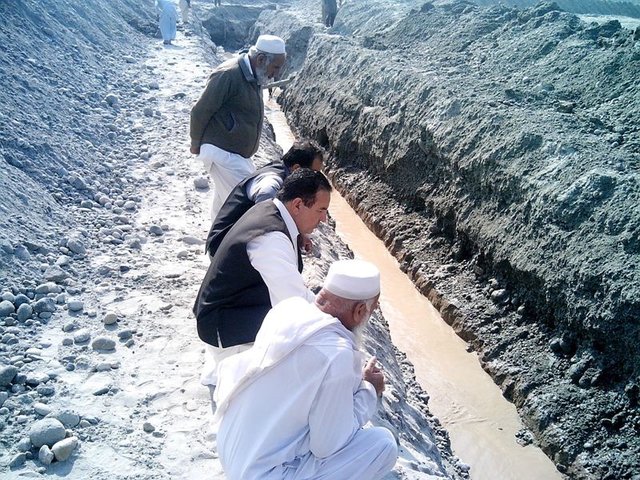
Sub-surface water harvesting for an efficient use of … [ปากีสถาน]
The purpose of this water harvesting technology is to capture, collect and distribute sub-surface water. First, an infiltration gallery is developed, which allows the percolation and collection of sub-surface water through perforated pipes at a depth of approximately 3-4.5 metres. Sub-surface water is filtered by gravel/sand underground and infiltrates into …
- ผู้รวบรวม: Eveline Studer
2. คำอธิบายของแนวทาง SLM
2.1 การอธิบายแบบสั้น ๆ ของแนวทาง
The overall purpose of WUMP is to compile an inventory of available water ressources in a particular geographical or administrative area, to identify communities' priorities in order to achieve an effective, equitable and efficient use of water resources at local level. This approach promotes a participatory and inclusive analysis and implementation of measures for a sustainable management of water, land and related resources.
2.2 การอธิบายอย่างละเอียดของแนวทาง
การอธิบายอย่างละเอียดของแนวทาง:
The WUMP approach has the following specific objectives:
- to assess water available resource, existing uses and requirements
- to determine water access rights and equity issues through inclusive and interactive dialogues
- to plan and manage water resources - considering multiple needs and uses - in a participatry manner.
- to prioritise required measures, considering climate change and disaster risks
- to promote coordinated water resource development for different stakeholders
- to promote a sustainable use of water, protecting water resources and preservation of the environment
- to strengthen local institutions
- to include economically and socially disadvantaged groups
- to promote an interactive dialogue for improvement of regulatory frameworks and policies in the water sector.
The methode involves field visits by field team to collect information from the community, which is done through focus group discussion, preparation of village maps, social and technical questionnaires
The WUMP process consists of four main stages: 1) Preparation; 2) Assessment/analysis of information ; 3) Planning ; 4) Implementation (see flow chart with according sub-steps).
The process and results of a WUMP:
Is based on a participatory process, which promote inclusiveness. It fosters coordination and collaboration among different local stakeholders including government, communities and private sector and helps to establish the baseline situation and a comun understanding. Land users and other local actors appreciate this approach as it promotes a participatory, transparent process for an equitable distribution of water and a sustainable management of water related resources. The approach helps to overcome potential economic or socio-cultural barriers, by providing a comun space for joint analysis, discussion and solution finding by facilitating interaction between stakeholders of different contexts.
2.3 รูปภาพของแนวทาง
2.5 ประเทศ ภูมิภาค หรือสถานที่ตั้งที่ได้นำแนวทางไปใช้
ประเทศ:
ปากีสถาน
ภูมิภาค/รัฐ/จังหวัด: :
Dera Ismail Khan Thensil (sub-division), Khyber Pakhtunkhwa (province)
Map
×2.6 วันที่เริ่มต้นและสิ้นสุดของแนวทาง
ระบุปีที่เริ่ม:
2014
การสิ้นสุดลง (ถ้าแนวทางไม่ได้ใช้อีกต่อไป):
2019
ความคิดเห็น:
The approach remains valid and applicable also after the termination of a project intervention.
2.7 ประเภทของแนวทาง
- ใช้โครงงานหรือแผนงานเป็นฐาน
2.8 เป้าหมายหรือวัตถุประสงค์หลักของแนวทาง
The main aim of the WUMP approach is to assess the availability of water resources, existing uses/demands and future requirements/needs. The WUMP helps to address water access, equity issues and balance these rights through interactive dialogues within the community and other local stakeholders. The WUMP approach contributes therefore actively to water governance and improved management of natural resources.
2.9 เงื่อนไขที่เอื้ออำนวยหรือเป็นอุปสรรคต่อการนำเทคโนโลยีภายใต้แนวทางนี้ไปปฏิบัติใช้
บรรทัดฐานและค่านิยมทางสังคม วัฒนธรรม ศาสนา
- เอื้ออำนวย
The approach helps to overcome potential economic or socio-cultural barriers, by providing a comun space for joint analysis, discussion and solution finding by facilitating interaction between stakeholders of different contexts.
การมีไว้ให้หรือการเข้าถึงแหล่งการเงินและบริการ
- เอื้ออำนวย
The implementation of the WUMP tends to increase access to water for production purposes with a positive impact for households/ communities' income.
The results of the WUMP process with its according priorities of intervention are recognized by local government and reflected in local annual development plans and according budgets.
- the WUMP defines options for other actors to investment in water sector based on communities' priorities.
การจัดตั้งระดับองค์กร
- เอื้ออำนวย
WUMP is steered by the district Coordination Committee at district level having representative from all concerned government departments, Water User Association including women members, representatives from civil society where they adress key issues and take decisionsof the local water sector.
การร่วมมือหรือการทำงานประสานกันของผู้ลงมือปฏิบัติ
- เอื้ออำนวย
Collaboration among actors is the central element of the WUMP, which pomotes a coordinated water resource development involving different stakeholders: communities and government and non-governmental organizations. The process, enables local institutions to consider needs and participation of economically and socially disadvantaged groups.
กรอบแนวทางในการดำเนินการด้านกฎหมาย (การถือครองที่ดิน สิทธิในการใช้ที่ดินและน้ำ)
- เอื้ออำนวย
WUMP addresses and defines solutions on water access & equity issues through interactive dialogues.
นโยบาย
- เอื้ออำนวย
WUMP can influence sector policies at local level based on the collections of baseline data and evidence, which contributes to improve frame conditions. Topics, priorities and challenges of the WUMP are addressed with stakeholders at district Coordination Committee, which can actively influence policies of the water sector.
ความรู้เกี่ยวกับ SLM การเข้าถึงการสนับสนุนด้านเทคนิค
- เอื้ออำนวย
The local stakeholders, namely communities are directly involved in the implementation of the WUMP, which improves their knowledge about SLM.
3. การมีส่วนร่วมและบทบาทของผู้มีส่วนได้ส่วนเสียที่เกี่ยวข้อง
3.1 ผู้มีส่วนได้ส่วนเสียที่เกี่ยวข้องในแนวทางนี้และบทบาท
- ผู้ใช้ที่ดินระดับท้องถิ่นหรือชุมชนระดับท้องถิ่น
Rural local communities, water & land users
Participation as an integral part in preparation at village level. Contribution to the assessment, prioritisation and implementation of the interventions
- องค์กรที่ขึ้นอยู่กับชุมชน
Water user associations (WUA)/ water users groups (WUG)
Responsible to support and facilitate the WUMP process, social support, provision of primary information. Ensure participation and involvement of all WUA members. Coordinate with relevant authorities and other development actors to identify technical and financial support in their area / water sector.
- ผู้เชี่ยวชาญ SLM หรือที่ปรึกษาการเกษตร
staff of the Water for Livelihoods Project : WUMP coordinator (engineer, male, 53 years), senior engineer (engineer, male, 43 years)
Coaching and guidance at all level, steering of WUMP process in collaboration with District Government, organize trainings as scheduled, support field teams for the collection of technical and social information/data.
- องค์กรพัฒนาเอกชน
Local partner NGO
Project implementation, social mobilisation and interaction at field level to ensure that the social dimension, local concerns deserving support are adressed and that the water user association (WUA) are inclusive and gender concerns are duly represented. Support water user associations in their advocacy efforts to mobilize resources for WUMP.
- ภาคเอกชน
Consultant
Compilation of data, collected information and writing of WUMP
- รัฐบาลระดับท้องถิ่น
District Authorities / Administration
Provision of legal and administrative acceptance, recognition and support to WUMP implementation. Support through provision of timely technical services to water user association /groups in WUMP implementation, validation of information (data regarding drinking water supply, irrigation, water use efficiency, soil conservation by Public Health Engineering Department, Irrigation Department, On Farm Water Management Department, Soil Conservation Department ). Participation to ensure a participatory monitoring and provide feedback to the district govt. for improvements in delivering of water sector services.
- รัฐบาลแห่งชาติ (ผู้วางแผน ผู้ทำการตัดสินใจ)
District and provincial governments
Policy dialogue counter-part to address WUMP issues, which require a change in policies, coordination and engagement with in-line authorities and to allocate resources for the integration and implementation of WUMP in the district development plan (ADP).
- องค์การระหว่างประเทศ
Swiss Agency for Development and Cooperation (SDC)
Financial ressources. Partner for advocacy and policy dialogues to address key topics in the water sector in their policy dialogue with national government representatives.
ถ้ามีผู้มีส่วนได้ส่วนเสียหลายคนที่เกี่ยวข้องให้ระบุหน่วยงานตัวแทน:
Water for Livelihoods Project
3.2 การเกี่ยวข้องของผู้ใช้ที่ดินระดับท้องถิ่นหรือชุมชนระดับท้องถิ่นในช่วงต่างๆของแนวทาง
| ความเกี่ยวข้องของผู้ใช้ที่ดินระดับท้องถิ่นหรือชุมชนระดับท้องถิ่น | ระบุผู้ที่มีส่วนเกี่ยวข้องและอธิบายกิจกรรม | |
|---|---|---|
| การริเริ่มหรือการจูงใจ | ปฏิสัมพันธ์ | Community through water user association (WUA) and water user group (WUG) in their actvities: support and facilitate the WUMP, ensure that all WUGs are involved in the process, link with relevant authorities and other development actors for technical and financial support development. |
| การวางแผน | ปฏิสัมพันธ์ | Community: WUA/WUG in their activities: Participate as an integral part in the preparation of WUMP at village level. Contribute to conducting feasibility, implementation and execution of interventions. |
| การดำเนินการ | ปฏิสัมพันธ์ | Community: WUA/WUG in their activities: Support a system for cost contribution by the community. Link with relevant authorities and other development actors for seeking the technical and financial support in their area water sector development. Promote and advocate for sustainable development in the water sector. |
| การติดตามตรวจสอบหรือการประเมินผล | ปฏิสัมพันธ์ | Community: WUA/WUG in their activities: Ensure equitable water rights and promote good water governance principles. Ensure strong linkages with WUA/community through regular meetings and documentation of decisions. |
3.3 แผนผังแสดงขั้นตอนการทำงาน (ถ้ามี)
คำอธิบาย:
The process of WUMP is divided into 4 stages consisting of 13 steps
ผู้เขียน:
Syed Hussain Mustafa, Khan Muhammad, Tawheed Gul, Munawar Khan Khattak
3.4 การตัดสินใจเลือกใช้เทคโนโลยี SLM
ระบุผู้ที่ทำการตัดสินใจเลือกเทคโนโลยีมากกว่าหนึ่งวิธีไปปฏิบัติใช้:
- ผู้ลงมือปฏิบัติที่เกี่ยวข้องทั้งหมดในฐานะที่เป็นส่วนรวมของแนวทาง
การอธิบาย:
The technology is selected via mutual consensuses at village council level. This process is facilitated by a SLM specialist. Women - as well as other vulnerable and marginalized groups - are also part of the water user association and participate in the discussion and decision making process. Where joint setting of men & women is not possible due to cultural constraints, separate meetings of men & women are conducted to cover the voices and concerns of both.
ระบุว่าการตัดสินใจตั้งอยู่บนพื้นฐานของ:
- การประเมินความรู้ SLM ที่ได้ทำการบันทึกไว้เป็นอย่างดี (การใช้ข้อมูลในการตัดสินใจ)
- ประสบการณ์และความคิดเห็นส่วนตัว (ไม่ได้ลงบันทึกไว้)
4. การสนับสนุนด้านเทคนิค การสร้างขีดความสามารถ และการจัดการด้านความรู้
4.1 การสร้างขีดความสามารถ / การอบรม
ได้มีการจัดอบรมให้แก่ผู้ใช้ที่ดินหรือผู้มีส่วนได้ส่วนเสียคนอื่น ๆ หรือไม่:
ใช่
ให้ระบุว่าใครเป็นผู้ได้รับการอบรม:
- ผู้ใช้ที่ดิน
- เจ้าหน้าที่ภาคสนาม / ที่ปรึกษา
- Government department specilist (SLM)
รูปแบบการอบรม:
- กำลังดำเนินการ
- เกษตรกรกับเกษตรกร
- จัดการประชุมสู่สาธารณชน
หัวข้อที่พูด:
Water resources conservation, efficient use of water resources, irrigation water distribution/ scheduling.
ความคิดเห็น:
Water Users are trained in different techniques of water conservation, such as water crop budgeting, local flow measuring techniques, irrigation scheduling with regard to specific crops.
The users are specifically trained in techniques for efficient water use, such as furrow irrigation, raised bed irrigation, mulching etc.
4.2 การบริการให้คำแนะนำ
ผู้ใช้ที่ดินมีการเข้าถึงการรับบริการให้คำปรึกษาหรือไม่:
ใช่
ระบุว่ามีบริการให้คำปรึกษาหรือไม่:
- ไปเยี่ยมชมสถานที่
- ที่ศูนย์ถาวร
การอธิบาย/แสดงความคิดเห็น:
SLM specialist made field visits and provided technical guidance to Land Users
The Land Users visited relevant organizations for technical guidance
4.3 การเสริมความแข็งแกร่งให้กับสถาบัน (การพัฒนาองค์กร)
สถาบันได้รับการจัดตั้งขึ้นมาหรือเสริมความแข็งแกร่งโดยแนวทางนี้หรือไม่:
- ใช่ ปานกลาง
ระบุระดับของสถาบันที่ได้รับการเสริมความแข็งแกร่งหรือจัดตั้งขึ้นมา:
- ท้องถิ่น
อธิบายถึงสถาบัน บทบาทและความรับผิดชอบ สมาชิก เป็นต้น:
Water User Association (WUA, local Institutions) at district & sub-district level were strengthened. The legally recognize WUA and Apex of the WUA take gradually responsibilities to support and facilitate the WUMP process. The WUAs strives for improvements in the water sector and are a catalyst to bring together and pool communities, civil society organisations, local authorities and other actors of different actors for to address water issues and development options.
ระบุประเภทของการให้ความช่วยเหลือสนับสนุน:
- การสร้างขีดความสามารถ / การอบรม
ให้รายละเอียดเพิ่มเติม :
Project provided trainings for 16 Water User Associations (WUAs) and 3 Apex WUAs in Chitral, Karak, and DI Khan. These 16 associations aim to improve development in the water sector, to improve water governance to contribute to resolutions in case of disputes amongst different water right holders for an equitable access to water at local and at district level.
Through these trainings, the WUGs/ WUAs members representing various groups/ associations - including representatives from Government Line Agencies are trained in community management & skill training, mediation in case of water disputes, monitoring/documentation and health/hygiene.
4.4 การติดตามตรวจสอบและประเมินผล
การติดตามตรวจสอบและประเมินผลเป็นส่วนหนึ่งของแนวทางหรือไม่:
ใช่
ความคิดเห็น:
The principle of the monitoring, is to actively engage the communities associations (WUA/WUG) and capture their observations and concerns.
This is done through direct feedbacks from communities, during regular field visits and interaction with technical departments, who receive feedbacks from communities based on regular exchanges.
ถ้าตอบว่าใช่ แสดงว่าการจัดเตรียมเอกสารนี้มุ่งหวังที่จะเอาไปใช้สำหรับการติดตามตรวจสอบและประเมินผลใช่หรือไม่:
ไม่ใช่
ความคิดเห็น:
This documentation is not primarily used for monitoring & evaluation purpose. However it contributes to establish a baseline.
4.5 การวิจัย
การวิจัยเป็นส่วนหนึ่งของแนวทางหรือไม่:
ไม่ใช่
5. การสนับสนุนด้านการเงินและวัสดุอุปกรณ์
5.1 ระบุงบประมาณประจำปีสำหรับแนวทาง SLM นี้
ถ้าหากว่างบประมาณประจำปีไม่เป็นที่ทราบแน่นอน ให้ระบุช่วงลงไป:
- 2,000-10,000
แสดงความคิดเห็น (แหล่งของการระดมทุน ผู้บริจาคคนสำคัญ):
The cost for the preparation of WUMP depends on the size of the area
5.2 การสนับสนุนด้านการเงิน / วัสดุอุปกรณ์ให้แก่ผู้ใช้ที่ดิน
ผู้ใช้ที่ดินได้รับการสนับสนุนด้านการเงิน / วัสดุอุปกรณ์ไปปฏิบัติใช้เทคโนโลยีหรือไม่:
ใช่
ถ้าใช่ ให้ระบุประเภทของการสนับสนุน เงื่อนไขและผู้จัดหามาให้:
The project and governamental counter parts (Department) provide material and technical support. The community provides in-kind contribution through labor and local material for the imlementation of the measures/ technology.
5.3 เงินสนับสนุนสำหรับปัจจัยนำเข้า (รวมถึงแรงงาน)
ถ้าแรงงานโดยผู้ใช้ที่ดินเป็นปัจจัยนำเข้าที่มีอยู่มากมาย ระบุด้วยว่าเนื่องจาก:
- สมัครใจ
5.4 เครดิต
มีการจัดหาเครดิตมาให้ภายใต้แนวทาง SLM หรือไม่:
ไม่ใช่
5.5 แรงจูงใจหรือเครื่องมืออื่น ๆ
แรงจูงใจหรือเครื่องมืออื่น ๆ ได้ถูกนำไปใช้ส่งเสริมการใช้เทคโนโลยี SLM หรือไม่:
ไม่ใช่
6. การวิเคราะห์ผลกระทบและการสรุป
6.1 ผลกระทบของแนวทาง
ทำให้ผู้ใช้ที่ดินระดับท้องถิ่นมีอำนาจขึ้น ปรับปรุงการเข้าร่วมของผู้มีส่วนได้ส่วนเสียให้ดีขึ้นหรือไม่:
- ไม่ใช่
- ใช่ เล็กน้อย
- ใช่ ปานกลาง
- ใช่ อย่างมาก
The approach supports land and water users to make decisions regarding water use by their own.
ช่วยในการตัดสินใจโดยดูจากหลักฐาน ได้หรือไม่:
- ไม่ใช่
- ใช่ เล็กน้อย
- ใช่ ปานกลาง
- ใช่ อย่างมาก
The preparation stage includes an analysis, where information for evidence and later decisions is collected. Once the effectiveness of the approach is recognized, it can be replicated by other communities them-selfs.
ช่วยให้ผู้ใช้ที่ดินนำเอาเทคโนโลยี SLMไปใช้และบำรุงรักษาสภาพไว้ได้หรือไม่:
- ไม่ใช่
- ใช่ เล็กน้อย
- ใช่ ปานกลาง
- ใช่ อย่างมาก
Land users are involved for the implementation and maintenance of the prioritized measures in the WUMP plan, which an efficient use water for productiion and drinking purposes.
ปรับปรุงความร่วมมือกันและการดำเนิน งานของ SLM ได้อย่างมีประสิทธิผลหรือไม่:
- ไม่ใช่
- ใช่ เล็กน้อย
- ใช่ ปานกลาง
- ใช่ อย่างมาก
The WUMP provides options for cost sharing mechanisms amongst different actors, to attract funding for prioritized initiatives. The prioritized initiatives of WUMP are jointly implemented by different stakeholders, which can reduce its costs.
ระดมกำลังหรือปรับปรุงการเข้าถึงแหล่ง เงินทุนสำหรับการดำเนินการ SLM หรือไม่:
- ไม่ใช่
- ใช่ เล็กน้อย
- ใช่ ปานกลาง
- ใช่ อย่างมาก
The results of WUMP (measures) are included in the official departmental annual development plans and budgets.
ปรับปรุงความรู้และความสามารถของผู้ใช้ที่ดินในการดำเนินการ SLM หรือไม่:
- ไม่ใช่
- ใช่ เล็กน้อย
- ใช่ ปานกลาง
- ใช่ อย่างมาก
The land and water users learnt how to analyse and assess water resources. They learnt about options to address the identified challenges.
ปรับปรุงความรู้และความสามารถของผู้มีส่วนได้ส่วนเสียคนอื่น ๆ ให้ดีขึ้นหรือไม่:
- ไม่ใช่
- ใช่ เล็กน้อย
- ใช่ ปานกลาง
- ใช่ อย่างมาก
Similarly, all other involved stakeholders' learn how to analysse and asses water resources and know about options to address them.
ทำให้ผู้ใช้ที่ดินระดับท้องถิ่นมีอำนาจขึ้น ปรับปรุงการเข้าร่วมของผู้มีส่วนได้ส่วนเสียให้ดีขึ้นหรือไม่:
- ไม่ใช่
- ใช่ เล็กน้อย
- ใช่ ปานกลาง
- ใช่ อย่างมาก
By establishing a district coordination committee to steer the approach (WUMP) all stakeholders can jointly discuss, address their needs and suggest options to be prioritized.
ช่วยบรรเทาความขัดแย้งหรือไม่:
- ไม่ใช่
- ใช่ เล็กน้อย
- ใช่ ปานกลาง
- ใช่ อย่างมาก
Through this approach all stakeholders - especially the up-stream & down stream users - can resolve their water related disputes through dialogue. This contributes to resolve disputes between communities and concerned department.
ทำให้กลุ่มด้อยโอกาสมีอำนาจทางสังคมและเศรษฐกิจหรือไม่:
- ไม่ใช่
- ใช่ เล็กน้อย
- ใช่ ปานกลาง
- ใช่ อย่างมาก
Disadvantaged groups participate in the preparation process of the plan, where they reflect and contribute with their concerns, needs and priorities.
ปรับปรุงความทัดเทียมกันด้านเพศและให้อำนาจแก่ผู้หญิงและเด็กผู้หญิงหรือไม่:
- ไม่ใช่
- ใช่ เล็กน้อย
- ใช่ ปานกลาง
- ใช่ อย่างมาก
Same participation as the disadvantaged groups. Women are also part of the decision making body.
ส่งเสริมให้เยาวชนหรือบุตรหลานของผู้ใช้ที่ดินให้เข้าร่วมใน SLM:
- ไม่ใช่
- ใช่ เล็กน้อย
- ใช่ ปานกลาง
- ใช่ อย่างมาก
Same participation as the disadvantaged groups. Generall people of the age group 30-45 have are the leader of associations - supported by their elders - to address and develop water ressouce management of their villages.
นำไปสู่ความมั่นคงด้านอาหารหรือปรับปรุงโภชนาการให้ดีขึ้น:
- ไม่ใช่
- ใช่ เล็กน้อย
- ใช่ ปานกลาง
- ใช่ อย่างมาก
Through the approach water efficient technologies are promoted, which allow to increase production and improve food security.
นำไปสู่การเข้าถึงเรื่องน้ำและสุขาภิบาลได้ดีขึ้นหรือไม่:
- ไม่ใช่
- ใช่ เล็กน้อย
- ใช่ ปานกลาง
- ใช่ อย่างมาก
Through the approach options to improve access to water for domestic use are promoted. Access to clean drinking water at households' proximity contributes to improved sanitation.
ปรับปรุงความสามารถของผู้ใช้ที่ดินในการปรับตัวให้เข้ากับการเปลี่ยนแปลงของสภาพภูมิอากาศหรือสภาพที่รุนแรงและภัยพิบัติหรือไม่:
- ไม่ใช่
- ใช่ เล็กน้อย
- ใช่ ปานกลาง
- ใช่ อย่างมาก
The result of the WUMP approach is a set of options, where efficient use of water and water saving technologies are promoted e.g. water harvesting.
6.2 แรงจูงใจหลักของผู้ใช้ที่ดินเพื่อที่จะนำ SLM ไปปฏิบัติใช้
- การผลิตที่เพิ่มขึ้น
WUMP aims to improve access and availability of water. More water for irrgation and efficient water use technologies contribute to increased yields. Consequently surface for agricultural production can be extended.
- กำไร (ความสามารถ) อัตราส่วนค่าใช้จ่ายต่อผลประโยชน์ที่เพิ่มขึ้น
By promoting efficient water utilization techniques, this can reduce costs, especially where power driven water pumping is involved.
- การเสื่อมของที่ดินลดลง
Earlier in areas of water scarcity flood irrigation, which leds to erosion, was applied. This approach helps to promote more sustainble irrigation options.
- ความเสี่ยงของภัยพิบัติลดลง
In the initial analysis stage of WUMP different water related hazards, mainly floods and droughts, are identified. As a result options to reduce according risks are identified and promoted.
- กฎและระเบียบ (ค่าปรับ) หรือการบังคับใช้
This approach help in aligning the traditional rules with formal rules and regulation in water management. The associations are not only right holders but they are also duty barer to communities.
- จิตสำนึกด้านสิ่งแวดล้อม
The approach promotes a sustainable water resource management. It promotes conservation and balances it with an efficient use of water fo rdifferent purposes. At the assessment stage potential problems related to unsustainable practices are analized and addressed.
- ความรู้และทักษะ SLM ที่เพิ่มพูนขึ้น
Communities are informed and empowered to identify and contribute to the implementation of options for sustainable water management.
- การบรรเทาด้านความขัดแย้ง
This approach provide opportunity to all stakeholders especially the up-stream & down stream users to resolve water related disputes through a joint dialogue. It further contributes to resolve disputes between communities and govtl. departments.
6.3 ความยั่งยืนของกิจกรรมของแนวทาง
ผู้ใช้ที่ดินสามารถทำให้สิ่งต่างๆ ที่ได้ปฏิบัติใช้โดยแนวทางนี้ยั่งยืนได้หรือไม่ (โดยไม่มีการสนับสนุนจากภายนอก):
- ใช่
ถ้าตอบว่าใช่ ให้อธิบายว่าอย่างไร :
For the prioritisation of technologies implemented through WUMP, options which require only minimal external inputs and are easy to sustain by the land user, where promoted.
6.4 จุดแข็งและข้อได้เปรียบของแนวทาง
| จุดแข็ง / ข้อได้เปรียบของแนวทางในทัศนคติของผู้ใช้ที่ดิน |
|---|
|
Participatory and inclusive process, which ensures ownership by local actors, promotes coordination and fosters partnerships between different actors. |
| The proritized measures selected through the WUMP approach promote a sustainable use of water resources through water conservation and efficient water use. |
| จุดแข็ง / ข้อได้เปรียบของแนวทางในทัศนคติของผู้รวบรวมหรือวิทยากรหลัก |
|---|
|
Strengthening of local institutional capacities, establishment ofan inventory/ data used as base line in the water sector. |
|
Flexible for improvement, since the WUMP is reviewed each 3-5 year |
| Officially recognized and accepted planning tool at regional level, which provides opportunities for investment by other actors based on communities' priorities. |
6.5 จุดอ่อน / ข้อเสียเปรียบของแนวทางและวิธีในการแก้ไข
| จุดอ่อน / ข้อเสียเปรียบในทัศนคติของผู้ใช้ที่ดิน | สามารถแก้ไขปัญหาได้อย่างไร |
|---|---|
|
Time consuming preparation process, high initial cost for the preparation |
Ensure regular feature of planing (continuous process) |
| Lack of technical capacities at local level | Capacity building trainings of local institutions (VOs/ WUAs/WUGs) in planning. Provide suport at local level through the project and government extension services. |
| จุดอ่อน / ข้อเสียเปรียบในทัศนคติของผู้รวบรวมหรือวิทยากรหลัก | สามารถแก้ไขปัญหาได้อย่างไร |
|---|---|
|
Replication and upscaling require talor-made adjustments |
Technical capacity building of govt. departments. |
| WUMP application in large scale in areas (big catchment areas, limited access) | Lobbying for support and resources at different governmental level. |
| Important mobilisation of resources by other stakeholders for implementation | Inclusion of WUMP priorities by the govt. department in their respective annual development plans. |
7. การอ้างอิงและการเชื่อมต่อ
7.1 วิธีการหรือแหล่งข้อมูล
- ไปเยี่ยมชมภาคสนาม การสำรวจพื้นที่ภาคสนาม
- field visit all involved villages, organisation of focal group discussions
- การสัมภาษณ์กับผู้ใช้ที่ดิน
land user where the key informants.
- การสัมภาษณ์ผู้เชี่ยวชาญด้าน SLM หรือผู้ชำนาญ
Meeting with technical departments for data/ information regarding their respective services and experience
- การเก็บรวบรวมมาจากรายงานและเอกสารที่มีอยู่
Support from secondary data/ reports of the concerned department, analysis of the primary data, compilation and reporting.
7.3 เชื่อมโยงกับข้อมูลที่มีอยู่บนออนไลน์
ชื่อเรื่องหรือคำอธิบาย:
Water Use master Plan (WUMP) Project experience Nepal, Helvetas Swiss Intercooperation Nepal
URL:
https://assets.helvetas.org/downloads/13_waterusemasterplan_wump_blau_final_engl_a4_portrait.pdf
ชื่อเรื่องหรือคำอธิบาย:
Water Use master Plan (WUMP) - facilitator's guide book, 2015, Helvetas Swiss Intercooperation Nepal
URL:
http://www.rainfoundation.org/wp-content/uploads/2016/04/Nepal-Module-final_SF.pdf
ลิงก์และโมดูล
ขยายทั้งหมด ย่อทั้งหมดลิงก์

Sub-surface water harvesting for an efficient use of … [ปากีสถาน]
The purpose of this water harvesting technology is to capture, collect and distribute sub-surface water. First, an infiltration gallery is developed, which allows the percolation and collection of sub-surface water through perforated pipes at a depth of approximately 3-4.5 metres. Sub-surface water is filtered by gravel/sand underground and infiltrates into …
- ผู้รวบรวม: Eveline Studer
โมดูล
ไม่มีโมดูล


